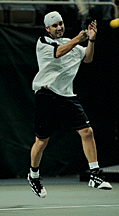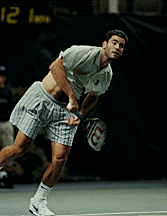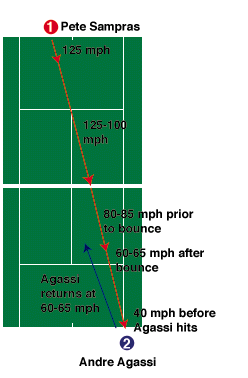|
TennisOne Lessons
By filming from baseline to baseline, the video captured the whole court and the flight of the ball on every point for the entire match. The result was that by advancing the video frame by frame during viewing, we could see how far the ball moved in each frame of video, or every 1/30 of a second. (To explain: with the shutter set at 1/1000, the camera was capturing 1/000 of a second every 1/30 of a second.) Watching the video with the naked eye, it was clear that after the first 2-3 frames the ball traveled less distance with every frame as it moved away from the server, definitely indicating that it was slowing down in speed. The question was how much? That question was easier posed than answered. Working with Nasif Iskander, a physics' teacher at San Francisco's University High School, where I have coached tennis for the past 15 years, we digitized some of the video into a Power Macintosh. We picked two examples: a Sampras serve in the add court to Agassi's backhand, and a wide Sampras serve in the deuce court to Agassi's forehand. Next we put this digitized video into a sophisticated motion analysis program. What came out were pages of graphs and some of the most frightening equations you can imagine, but eventually, we also produced some very interesting and unexpected information on the speed of the ball. To the best of my knowledge, this was information that had never been studied or made available before.
But the computer showed that the bounce caused the ball to slow down even more dramatically. Just after the bounce, the ball slows down to about 65 mph, and in the split second before Agassi hits the return, the ball can slow down to 40 mph or less! And what about the return? If you think Agassi can return the ball faster than it comes to him, you're right. The speed of his returns averaged 60-65 mph, up to 25 mph faster than the ball was traveling when he hit it. If the ball changes speed so dramatically, why isn't that apparent to the average spectator? Keep in mind it takes only about 2/3's of a second for the ball to travel from Pete's racket to Andre's. That's not much time if you don't know what to look for. But there is a ground breaking lesson here for return of serve, particularly for anyone who's faced a big server. Don't panic when he hits the ball. See the ball after the bounce. You still have time to hit it, as the ball is slowing down as it moves across the net to you--and slows down much more (relatively speaking) once it bounces. If you know to look for this change in speed, you will find that it is actually easy to see. Focusing on it has the capacity to drastically improve your timing on the return. What's it like to put this information into practice returning serve? Scott Murphy, currently ranked #7 in Northern California Men's 45 and over singles and a well known Marin teaching pro put it this way:
One more interesting fact on ball speed physics. The computer showed that a wide serve that normally registers about 20 mph slower on the radar gun is actually traveling at about the same speed as a serve hit down the middle, confirming something commentators have been speculating about for some time. This is because the radar gun behind the server is pointed at a right angle to the net. When a wider serve moves out of the parallel plane of the radar gun's beam, the radar reading is less accurate and tends to indicate a slower serve than what has actually taken place. At this point, we have only analyzed a small number of exchanges, due to the time consuming nature of the process. We are, however, pursuing additional funding for this work and hope to make the results part of an interactive web textbook that teaches basic principles of science to students across the country. Stay tuned for more tennis physics updates. Eventually we hope to have similar data for the groundstrokes and volleys, as well as the differences in speed between different types of spin. Send email to the author We encourage you to email your comments (pro, con, appreciative, whatever) directly to the author. To send email to John Yandell, click here. To see John Yandell's Visual Tennis series on TennisONE, Click here. |


